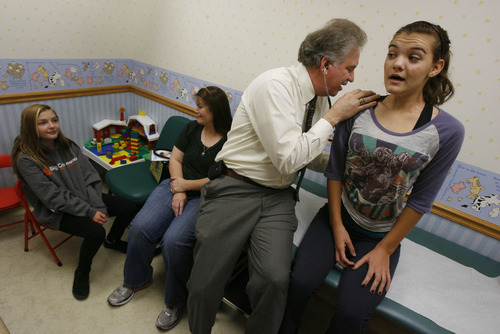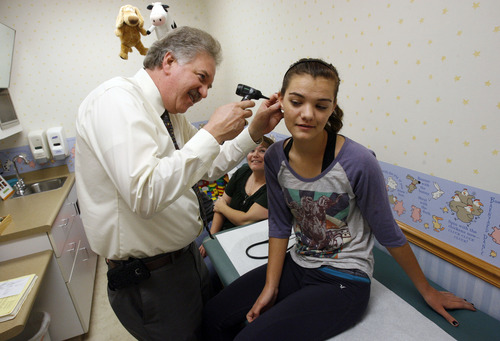This is an archived article that was published on sltrib.com in 2012, and information in the article may be outdated. It is provided only for personal research purposes and may not be reprinted.
At least three private colleges see Utah as fertile ground for new physician training programs that could provide the state's first alternatives to the University of Utah's medical school.
Colorado-based for-profit Rocky Vista University may develop a school of osteopathic medicine in Cedar City. The nonprofit Lake Erie College of Osteopathic Medicine, the nation's largest medical school, wants to send students to Utah hospitals for training and potentially open a future school.
Roseman University, a nonprofit school, also recently considered developing an osteopathic medicine program. Instead, its board of trustees will decide next month whether to establish a traditional medical school that awards MD degrees, according to Mark Penn, the South Jordan chancellor of the Nevada-based school.
Motivating these schools is not just the state's need for doctors but also the above-average rates at which Utahns apply to both traditional medical schools and schools of osteopathic medicine.
Despite this demand, the U. cut its annual medical school admissions from 102 to 82 a few years ago, although officials hope to soon restore the class size and eventually increase it to 122. More than 400 students leave the state each year for their medical degrees, and many never return to practice, said Brennan Wood of the Iron County Office of Economic Development.
Utah is ripe for new medical programs, believes James Moore, vice president for institutional development for Lake Erie College of Osteopathic Medicine (LECOM). "Even if a third or fourth school opens, that's not going to be enough," he said.
But one major obstacle: lining up the hospitals, clinics and physicians willing to provide the crucial training slots for these students, both before and after graduation.
—
Learning clinical care • Cedar City economic development officials are working with Rocky Vista University, which just graduated its first class of doctors, to develop a school of osteopathic medicine.
The hope is to alleviate a growing physician shortage in rural areas, while expanding educational opportunities for aspiring physicians, Wood said.
Southern Utah University already sends some pre-med graduates, such as Preston Gilbert, of Parowan, to Rocky Vista's Parker, Colo. campus.
"It would be a boost for the local economy for starters," said Gilbert, a father of four now in his second year of its four-year program. "There's a lot of very bright individuals from Utah. ... A lot of us are leaving the state because there is not enough spots to field demand."
Traditional medical schools are typically attached to teaching hospitals, where students serve clinical rotations — short stints of hands-on training from pediatrics to surgery. Osteopathic schools often disperse their third- and fourth-year students into community-based clinics and hospitals, instead.
Rocky Vista has established rotation slots throughout the southern half of Utah, including the state hospital in Provo, where its students shadow board-certified psychiatrists for a month.
Gilbert expects to return with his family to the home they own in Parowan while he pursues clinical rotations during his third and much of his fourth year. His goal is to be a family practitioner in Parowan.
In Utah County, Moore is trying to persuade Utah providers to provide clinical rotations for LECOM students from its two Pennsylvania campuses and a third in Florida. LECOM is collaborating with Provo's Rocky Mountain University of Health Professions, a for-profit school.
—
A bigger challenge: residencies • Opening a school in Utah, Moore said, would require even more cooperation from providers — spots for students to serve residencies of at least three years residencies after they graduate to gain the real-world experience necessary to turn them into practitioners.
"We are looking for political and clinical support," Moore said. "Residency opportunities would need to be greatly developed. It would be premature to say we are building a school, but on the other hand that is where we would like to be headed if the support is there."
Rita Osborn of the Utah Center for Rural Health believes the state can develop a rural residency program. "We have an abundance of rural practitioners who are willing to teach," she said.
Residencies are "the bottleneck" for any effort to boost the number of Utah doctors, said Sri Koduri, interim executive director of the Utah Medical Education Council.
"If we don't do something to expand residency training, the issue of physician workforce development is not going to solve itself, " Koduri said. "The likelihood of someone staying in the state is more tied to residencies than anything else."
The University of Utah's health system already accepts a small number of osteopathic residents, said U. spokesman Christopher Nelson. Whether the U., which is lobbying for state funding to grow its own medical school, can accommodate more, Nelson couldn't say.
"At the end of the day," he said, "we're looking for the best and brightest physicians to work in Utah."
He doubts osteopathic schools are the answer to the nation's primary-care doctor shortage. The U.'s public medical school provides "a quality education for a lot less than private schools. If you graduate $300,000 in debt, it's questionable you'll be able to pay that down as a primary-care doctor."
But Osborn insists Rocky Vista's tuition will be reasonable. And its first graduating class snagged residency slots "with primary care, but also anesthesiology, surgery and emergency medicine. They bring to the table a high quality product."
—
'We love him' • Both osteopathic practitioners, called DOs, and MDs attend four years of medical training followed by a residency. Both can prescribe drugs, perform surgery and become board certified in a specialty.
Any differences are mainly philosophical, said Keith Ramsey, an osteopath with a pediatric clinic in South Jordan.
DOs are trained in a form of musculoskeletal manipulation similar to that practiced by chiropractors. Not all osteopaths use manipulation; Ramsey says he rarely uses it because so few of his 3,200 patients need it.
A member of Utah's osteopath licensing board, Ramsey isn't aware of any such doctors who claim to cure ailments such as diabetes through massage or by manipulating the spine. He chalks up misunderstandings about osteopaths to ignorance, "not willful ignorance, just a lack of understanding."
Ramsey acknowledges turning to osteopathy after he was rejected by medical schools, but says the training he received was just as rigorous. He has practiced medicine for 27 years.
Sixteen-year-old patient Kaylee Franklin saw him for a checkup earlier this week. "I've been seeing him since I was 2 months old," she said. "My whole family goes here, all my cousins."
The West Valley City teen complained of a lingering sore throat and a possible sinus infection. Her dad was just hospitalized for pneumonia, she noted.
Franklin's mom, Michelle Rob, picked Ramsey the same way most people choose doctors, by word-of-mouth. "My mom, who is a nurse, said he's the one, he's where you need to bring the kids," she said. "We love him. We've followed him to three different clinics."
Ramsey asked Franklin diagnostic questions and listened to her chest. "You don't have pneumonia," he said. After peering into her ears and nose, he prescribed antibiotics to clear up signs of infection and urged her to get a flu shot. Grimacing, she opted for the mist, instead.
"Are you OK swallowing large pills?" he asked.
"You gave me those horse pills last time," Franklin said, "so yeah."
By the numbers
MDs and osteopathic doctors
9.4 per 100,000: Utah's per-capita applicants to schools of osteopathic medicine, the nation's highest rate and more than double the national average.
16.8 per 100,000 : Utah's per-capita applicants to traditional medical schools in 2010, versus the national average of 13.7.
29 : Colleges of osteopathic medicine in the U.S., with 20,000 students, or a fifth of all medical students.
500: Pre-med graduates produced by Utah colleges and universities each year
82: Medical school slots at the University of Utah
8,700: Licensed MDs in Utah
508: Licensed osteopathic doctors in Utah
Sources: Utah Division of Occupational and Professional Licensing, American Association of Colleges of Osteopathic Medicine. —
Two training tracks
Comparing osteopathic doctors, DOs and graduates of traditional medical schools, MDs.
Training
Both DOs and MDs attend four years of medical training, almost always after earning four-year college degrees.
In their third and fourth years, both DOs and MDs do "clinical rotations," or short stints working in specialties, under the supervision of physicians.
After graduation, DOs and MDs serve residencies that last three to eight years. Osteopathic students can apply for traditional residencies through the National Resident Matching Program. MDs are not eligible for osteopathic residencies arranged by National Matching Services.
Some osteopaths apply to both matching programs. But most traditional spots go to MDs.
In 2003, 99 percent of new MDs and 43 percent of new DOs were matched to traditional residencies, according to research by the American Medical Student Association.
Philosophy
DOs are trained in a form of musculoskeletal manipulation similar to that practiced by chiropractors. According to the American Osteopathic Association, it is used "to identify and correct structural problems, which can assist your body's natural tendency toward health and self-healing."
Not all osteopaths use manipulation. Sixty percent of ODs provide primary care, compared to 40 percent of MDs, the association says.





